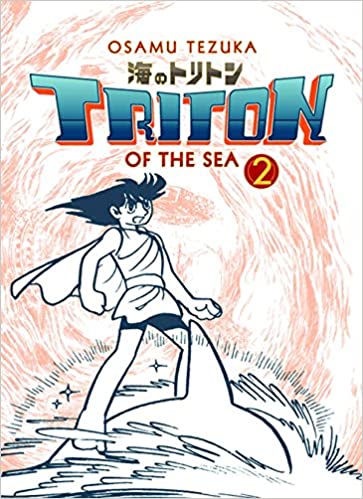Manga Review: Triton of the Sea 2 by Osamu Tezuka
WARNING: This review contains massive SPOILERS for Volume 1 of Triton of the Sea.
Triton, last surviving male member of the Triton Clan of sea-dwellers, has managed to survive everything the Poseidon Clan has thrown at him, including the 33 children of King Poseidon himself. He’s also managed to find the sole known surviving female member of his clan, Pipiko. Now it’s time to find a safe place to live and then–revenge!

The volume opens with an explanation of where the mer-beings come from. It seems that the kingdoms of Atlantis and Mu were highly advanced in magical science and developed techniques for fusing the genetic material of different beings together to create new species. The Poseidon Clan specialized in chimeric beings that combined multiple animals together that produced great power but monstrous appearance. Their crowning achievement was the Poseidons, a line of immortal kings.
The Triton Clan, conversely, turned themselves into a genetically stable race of merpeople (males with legs, females with tails) who were not only amphibious but aesthetically pleasing. The kingdoms of the pre-disaster world chose the Triton Clan to be protectors of the sea. The Poseidon Clan was outraged by this snub, and declared war on the Tritons.
While this war was going on, Mu and Atlantis suffered catastrophe and sunk. The amphibious Poseidon Clan survived in a small city with the remaining Mu supertechnology, while the Triton Clan was reduced to scattered tribes which were slowly exterminated by the still vengeful Poseidons. Eventually the Triton Clan was reduced to Triton, who was raised by humans in rural Japan, and Pipiko.
Which brings us to the present day. Triton, Pipiko and their dolphin allies need a safe place to live, and appeal to the giant tortoise Ganomoth. The ancient being offers them the shell of his great-grandfather, which is now an artificial island surrounded by dangerous whirlpools. He also counsels Triton to give up his vendetta against Poseidon.
While grateful for the hideout, Triton still bears a grudge against his clan’s enemy, and after stashing Pipiko at Tortoise Shell Island, heads for the sunken city.
What follows is a series of events that gets a bit complex. We switch to Poseidon’s point of view for a while. While the Poseidons are powerful and immortal in the sense of being unable to die, they still age, and as soon as they’ve produced a suitable heir, go into hibernation. The current Poseidon is getting up there in age, and tires easily now, but his 33 previous children were not immortal (and Triton killed all of them.)
Now Poseidon needs a new bride to make a 34th try, and all the signs point to Pipiko as the best choice. So despite the hazards of getting to Tortoise Shell Island, the mermaid is kidnapped.
Much to my relief, the production of a child by Poseidon involves him and the bride getting into a superscience device that blends their genetic material and creates a full-grown offspring. This is not explained to Triton, holed up elsewhere in the base, who assumes that Pipiko will “betray him” with Poseidon. (That’s a strange way of phrasing “will be raped by”, Triton. This is not one of your better moments.)
As it happens, another “bride” is substituted, and the subsequent battle with the 34th child of Poseidon allows Ganomoth to finally negotiate a peace treaty. Safe at last, Triton and Pipiko are able to have children of their own. (Mermaids lay eggs.)
But on a trip to the outside world, one of Triton’s children is captured by a Japanese fisheries official who has a plan for breeding mermaids as…um…well, maybe pets, but as folklorists know, there is a Japanese tale that eating the flesh of a mermaid gives immortality. Nevertheless, Triton rightly considers this unforgivable, and goes to rescue his daughter Green with the help of his son Blue.
The Poseidon Clan sees their chance. Their other main goal is to conquer the land-dwellers, and they work to turn Triton and the Japanese people against each other, and then the clan will attack the weakened survivors.
This leads into a final battle against Poseidon, but although that menace is at last ended, the future of the Triton Clan is still in doubt….
There’s plenty of exciting, imaginative action in this series, leavened with some silly humor. There are interesting monster designs, and some discussion of environmental issues.
The ending is bittersweet, and will not be to everyone’s taste.
On the less good side, Pipiko is more of a trophy than a person with agency, and is actively useless in an air environment. This is one of those old-fashioned adventure stories where the men are the ones getting things done. And this extends into the next generation, where Green is largely a passive captive while Blue actively seeks her and Triton with the help of human allies.
While not as bad as Namor about it, Triton does have a bad temper and a vengeful streak that gets in the way of more sensible actions.
Content notes: Lots of dolphins are hurt and killed, some South Sea Islanders are depicted with exaggerated features that come off as racist (and this gets a note to the readers from the translation staff), peril to children, a monster uses noxious body fluids as a weapon.
Overall: This story is very influenced by Greek mythology, and Triton comes off as a well-done pastiche of a Greek hero of that type, for good and ill. It’s something you’ll want to check out at your library if you can before investing in your own copies.
There’s an anime adaptation as well:

